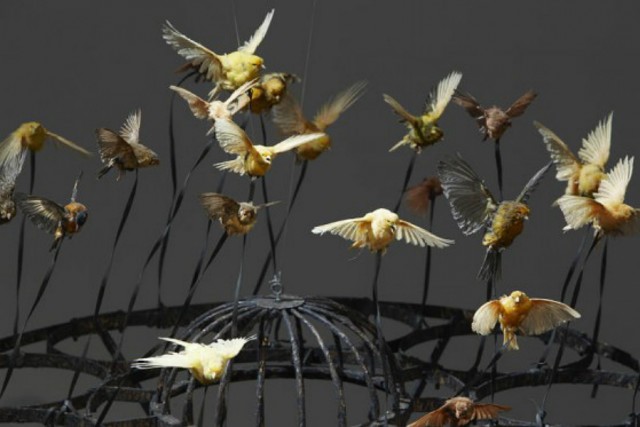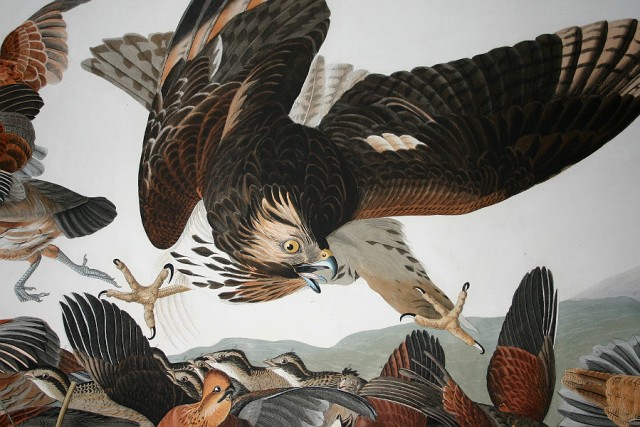Living in a different time: Polly Morgan
Ahead of her live taxidermy demonstration tonight at the Victoria Gallery, artist Polly Morgan talks to curator Laura Robertson…
How does it feel to be working in the VGM, sharing gallery space with the John James Audubon artworks and the rest of the 19th and 20th century collections?
It’s my first time being here; when I started reading the briefs from the various museums that were interested in having me up for Light Night, the VGM appealed to me straight away. The lecture theatre was mentioned in the brief and I thought wow, that would be the perfect setting. I had visions of people doing autopsies in the past and that kind of thing. Just seemed like an appropriate setting. I was keen to see the Audubon stuff.
I’m interested in the relationship that Audubon had with nature. The exhibition I am curating, Spectacle of the Lost, looks somewhat at how Audubon shot and stuffed wild animals in order to study them as an artist, eventually contributing to the extinction of the passenger pigeon in the US. Liverpool is also host to a Galapagos exhibition at the moment – artists including Jeremy Deller and Marcus Coates recorded their residencies on the islands, including debating the preservation on the islands and damage tourists are doing to the habitat there. What responsibility do you think that artists have when working with animals or the natural environment?
I think it changes a lot with the passing of time really. I can see why someone like Audubon would kill things … one hundred-odd years ago we didn’t have the reference material we have now. We didn’t have zoos, or planes taking us abroad, and so to have that access to nature that we have now… Living in a different time I would have probably done exactly the same thing. I just made the decision very early on that it was completely unnecessary to kill anything. I don’t like the idea of killing anything because I love animals. On top of that it’s not necessary, I can access dead animals easily. My work is not about the study of nature, about bringing nature to people who haven’t seen it before, its not an educational thing. We are naturally curious people, always trying to further our understanding of life, and that was the way [the Victorians] went about it sadly. To repeatedly kill the same thing and contribute to its extinction maybe went a little bit far! Darwin was a taxidermist and brought things back that no one had ever seen before. Even though I’m a meat eater and don’t have a very strong stance on the killing of animals for meat – even though most modern farm practices could do with a lot of improvement - I think that to kill something in order to make it look alive again is just perverse and lazy really.
There’s a really great example of that in this room – a painting of a Red Shouldered Hawk amongst Virginia Partridge (pictured). I’ve never seen a more unnatural-looking hawk.
The amount that we learnt from doing that all those years ago, I don’t think we would take that back if we had the chance. Remove all that knowledge and understanding. Now I can just switch a David Attenborough film on and watch that, I don’t have to take out a shotgun and kill a load of things to get up close and have a proper look at them.
Can you explain a little more your relationship with animals. I’m interested to know more about this contrast between love for animals and the sale of animal-based artwork, can you tell me more how you feel about animals, and this difference between dead animals that you perhaps weren’t familiar with and your pets?
Sure. If I cared about every animal that came into my house I wouldn’t be able to do what I do. So I have to get my head around that and find a way to work with the animals without sentimentalising them. I think that is a bit of a danger, humans tend to over sentimentalise animals – animals kill each other all the time and eat their dead. They don’t sit at a graveside and mourn their dead the way that we do.
You mean the way some people tend to anthropomorphise animals?
Yeah. When I get criticised it’s always by people saying that I’m disrespecting the dead, and I just don’t think that the kind of respect we give our own bodies applies when you’re talking about animals. The type of respect we give our dead is on behalf of their families, not really for the person that once inhabited that body. I certainly don’t care what happens to my body when I die, but obviously my mum or my sister would care. Its kind of foisting human sentimentality onto animals, and I’m of the opinion that there are far worse things to worry about. I didn’t ‘know’ the animals that I work with when they were alive, and there’s nothing I can do to change the fact that they died. As long as I know I haven’t killed them or ordered its execution, then I’m more than happy to work on it. I suppose I’ve become quite immune to dwelling on life and death when I’m working; I look at my dogs and I can see something different because they’re alive, quite simply. When they died I would have all those memories that would interfere with my working process so I wouldn’t be able to do anything with them.
Your exhibition The Age of the Marvellous in a way celebrates the Victorian sense of adventure and invention, this is what appeals to me about Audubon; his sense of discovery. What was it for you about the Victorian era that inspired your work?
I suppose there was just a kind of fearlessness back then that we don’t have now. We are obsessed with cleanliness and health and safety and many modern fears that have prevented us from being as adventurous and brave as people were. That’s something that irritates me about the modern world. It’s something that I’m always drawn to. I like the aesthetics of the Victorian age too; but at the same time I’m not interested in nostalgia, or in recreating something that exists. There’s absolutely no point in doing that as far as I’m concerned. But I take elements that they found interesting and try to modernise them and bring them up to date, and combine then with much more contemporary things. Otherwise, I wouldn’t really consider myself to be an artist, I’d just be restoring old stuff.
Lastly, I’m interested in what’s next for you. What new things are you working on?
I’m working on a solo show called All Visual Arts in Kings Cross in London, with four new sculptures, two of which are the largest things I’ve ever done. I’ve made a series of drawings too, with cremated bird ash – crushing the ash up a little finer than it comes back from the funeral parlour (it’s actually quite gritty), and drawing with PVA and water with brush and quill pen, then scatter the ash onto it, and pour the ash off, then etched onto that. Beyond that, no big plans, probably something in Venice next year. Oh and a group show in Warsaw in 2013.
Will taxidermy still play a starring role in your work?
I don’t know whether it will play the starring role forever. I have more and more ideas that don’t involve taxidermy, or much anyway. To start with my instinct was to crowbar some taxidermy in there, because I’m used to doing it, but I’ve realised that more and more that it doesn’t have to be the primary thing. I can conceive that one day I will have a drawing or sculptural show with little or no taxidermy. I’m not in a rush; I’m just going with whatever inspires me, and I guess that I am finding working with taxidermy exclusively a little restricting. There’s only so many ideas I can have that involve it.
Laura Robertson
Polly gives a live taxidermy demonstration at the VGM 7-8.30pm tonight as part of Light Night








